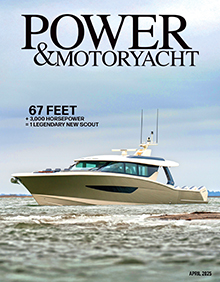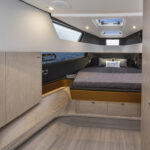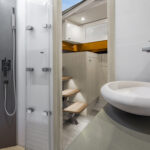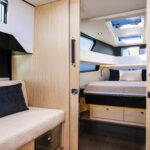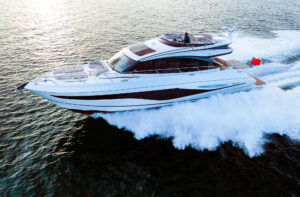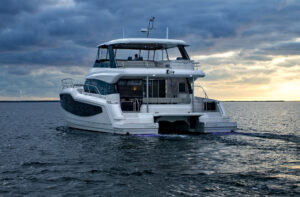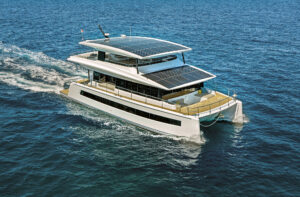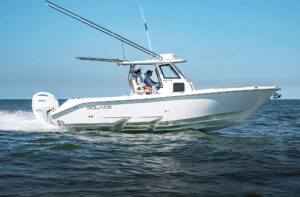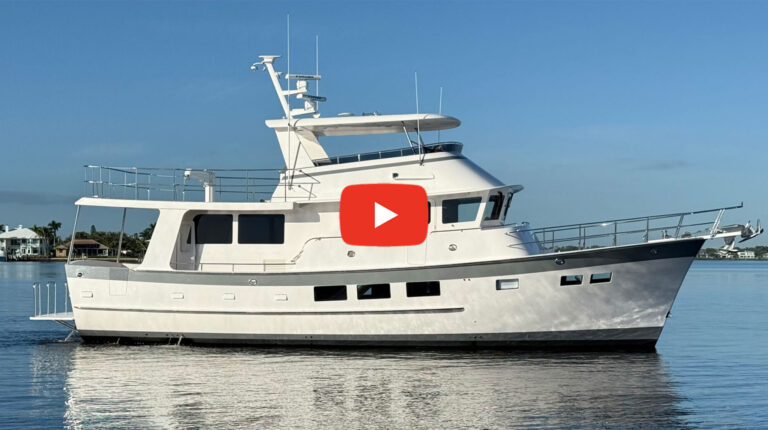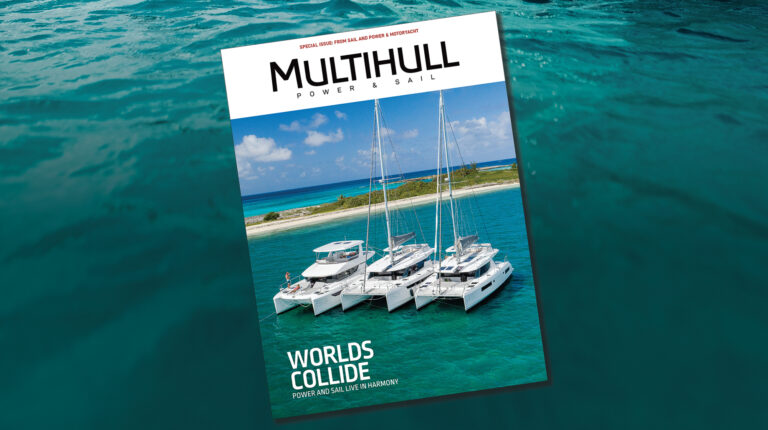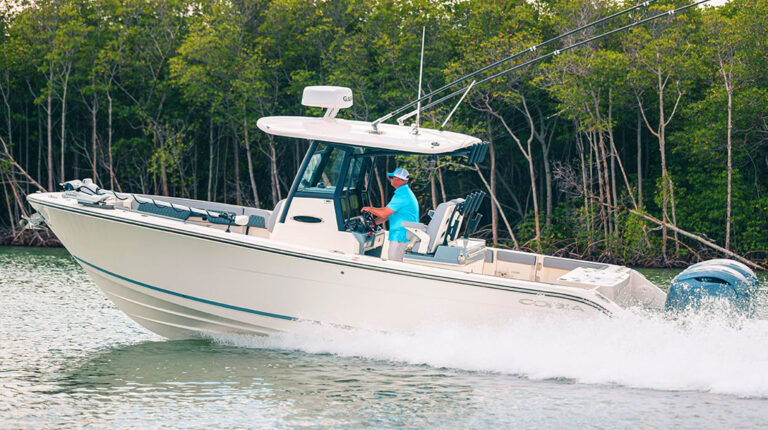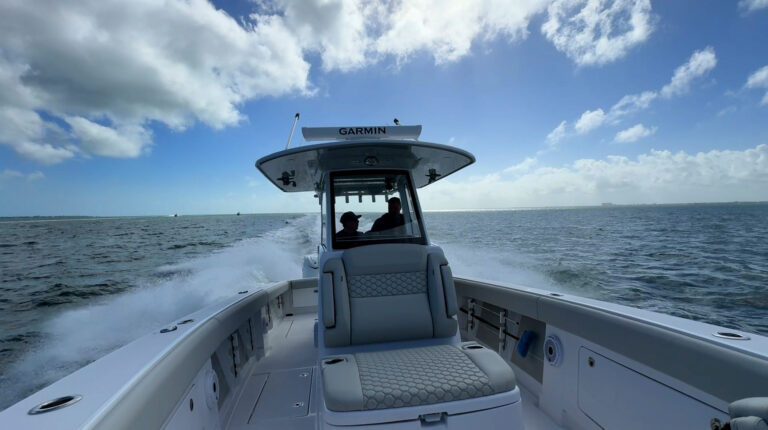Nordic Tough
A Norwegian brand with an illustrious heritage is brought fully up to date by its German owners—but with a nice, old-school touch.

We all have plenty of surreal memories to take away from these virus-stricken times, but there’s one that seems especially destined to stick in my mind: When I opened a cockpit locker and found it crammed full of packets of biscuits. It was mid-September, Southampton boat show week, and I had discovered the boat dealer’s stash of show snacks. Only we weren’t in Southampton. The show had been canceled the night before it was supposed to open. At least we wouldn’t go hungry during the sea trial.
The boat was only a few miles from the show site, on the dealer’s berth at Hamble Point. If we couldn’t be at the show, this was the next best place—England’s powerboat central, a kind of genteel, bucolic version of Miami’s NE 188th Street where, in offshore racing’s glory days, the docks were full of deep-V hulls and the summer air was filled with the sound of high-powered engines. Here, Fairey Marine introduced the deep-V hull to Britain with its famous Hunt-inspired craft, turning them out by the hundreds from the iconic big blue sheds where, in an earlier era, Fairey Aviation built its naval float planes. In the ,᾿70s and ᾿80s this was where Cougar Marine developed its world-beating offshore catamarans.
Everything now looks pretty new, but around here modernity is only skin deep. Parallel steel tracks crossing the concrete turn out to be the last traces of another old Fairey shed. Rusting pre-war launching rails run down the shingle beach. Just around the point, an old anti-aircraft gun emplacement, complete with 40-mm Bofors, faces out to sea.
With its angular Patrick Banfield design, fashionable slab sides and plumb bow, the Fjord 41 XL doesn’t place you in the past—unless you know your history. The Norwegian boatbuilder, owned since 2005 by Germany’s Hanse Group, once expressed the spirit of the ‘60s as eloquently as the mini skirt or the E Type Jag. Superb designs by the legendary Jan Linge first took Scandinavia by storm, and then the rest of Europe—one more affectionately remembered, perhaps, than the Fjordling of 1962, a diminutive cabin runabout with a seaworthy 24-degree deep-V hull, which ran rock-solid at insane speeds with a huge outboard. It retains as enthusiastic a following now as it did in its racing heyday.
Key to Scandinavia’s success with offshore powerboats back in the day was the Volvo Aquamatic sterndrive. So, at a time when you could be forgiven for assuming that IPS pods are a legal requirement on boats like this, it was excellent to see a pair of Volvo’s DPI Duoprop drives sticking out the back of the 41 XL. Call me old-school—IPS is great—but nothing imparts the feeling of a fast boat quite like a quality outdrive.
The 41 XL takes the existing Fjord 40 Open concept and improves upon it, not just with sterndrives in place of IPS, but with wider-set supports for a much larger T-top, and such a variety of modular seating layouts for the cockpit that it borders on the bewildering. Our boat, which happened to be the first example out of the shed, had the parallel thwartships sofas with flipover backrests, extendable tables and a sunbed. You can also choose either three or four forward-facing seats at the helm.

Down below, the options are less onerous but still significant. Non-negotiables are the forward double berth and the head and shower compartment on the starboard side. Over to port you can choose to have storage, a galley or a sofa, while tucked behind the steps in the space amidships our test boat had a good-sized bed. It has less than 2 feet, 6 inches of clearance, but it would be fine for lying down. Alternatively this area can be given over to a large and useful storage void. My inclination would be to ask for the bed—it might come in handy, and you can always store stuff down there anyway.
This lower-deck area is far from an afterthought, in spite of the 41’s emphasis on the outdoors. Headroom in the central cabin area is 6 feet, 4 inches, and the tapering bed and large hull windows both add in their different ways to a sense of spaciousness. On top of all the layout choices, plenty of décor options exist down here too.
As its name suggests, Hamble Point sits at the tip of the low-lying, marshy land where the Hamble river emerges into Southampton Water, with the Solent and the Isle of Wight to the south and the city and port of Southampton itself about 5 miles up the estuary. Oil storage tanks, the power station and the refinery dominate the opposite bank, where once there were noisy shipyards, flying boats and the fast military launches of the British Power Boat Company doing speed trials along the measured mile—whose three pairs of transit posts are still there, if you look closely.
Luckily we had no need of those. This is still a busy stretch of water, full of yachts and fast ferries and large, escorted commercial ships whose possession of the deep-water channel is not up for negotiation. The 41 XL comes with 340-hp Volvos as standard, which would undoubtedly be fine, but I recommend the D6-440s that were
fitted to our test vessel, which rocketed us to a top speed of over 37 knots almost as quickly as we could push the throttles home. The fast ferries of the Red Funnel line run constantly, kicking up a wake that is truly gratifying if you’re sea-trialling a fast powerboat, though perhaps less so if you’re in a sailboat trying to make a cup of tea. The Fjord’s razor-like bow sliced through it like cheesecake.
This being the first 41 XL, effectively a prototype, it had a couple of issues that were due to be sorted out back at the shipyard. The first was an exhaust back-pressure problem, preventing the engines from running to their full potential. The cost was a couple of knots, I was told. The second was an aspect of the boat’s longitudinal trim, which was due to be addressed by sliding the engines back a few inches. Volvo’s automatic trim system was so effective, however, that I was completely unaware of any such issue.
What I was aware of was how much Duoprop drives bring to the party. I don’t think I found the boat’s handling limits; however much lock I wound on, it just heeled more and turned tighter. Throttle response was virtually instantaneous, and the transmission of torque into the water meant that such wild and woolly maneuvers incurred very little speed penalty. Wherever you pointed it, the boat just went, as eagerly as a spaniel pup.
Fun? Yes, it was fun. And best of all, there was no shortage of snacks.
Fjord 41 XL Test Report

Fjord 41 XL Specifications:
LOA: 42′
Beam: 13’1″
Draft: 3’10”
Displ.: 25,485 lbs.
Fuel: 238 gal.
Water: 88 gal.
Power: 2/440-hp Volvo D6-440 DPI
Price: $680,000

